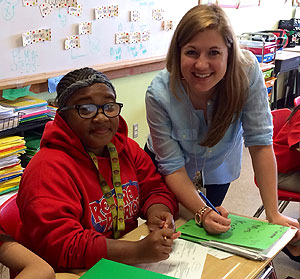11.09.15Erin Krafft Uses Just Enough Correction- & a Smile- to Keep Students On-Task
 Two weeks ago we watched footage of Erin Krafft, a 6th grade teacher from Houston Independent School District’s Revere Middle School. We blogged about how she installed a beautiful and productive system to ensure quality discussions during her Turn and Talks.
Two weeks ago we watched footage of Erin Krafft, a 6th grade teacher from Houston Independent School District’s Revere Middle School. We blogged about how she installed a beautiful and productive system to ensure quality discussions during her Turn and Talks.
This week we want to share another tiny moment from Erin’s teaching. It’s a seemingly mundane interaction where she’s managing attention during a transition and correcting distracted behavior. It’s a clip we loved as much as that brilliant Turn and Talk clip because it provides a tiny glimpse into how Erin builds a strong foundation of positive behavior to support her rigorous academic expectations. We see, especially, a lot of Firm Calm Finesse (technique 54) that elicits student trust.
The clip starts out with Erin’s students working independently. She asks for their attention—“Eyes up here in 3,2,1,” so THEY can move on to the next task. As she does so, Erin deliberately scans the classroom to ensure that she sees whether students stop working and give their attention back to her as she’s asked. She notices, at the end of her countdown, some students near the back that aren’t quite ready, so she uses an Anonymous Individual Correction, “Waiting on three sets of eyes.”
This correction appears to be sufficient and Erin thinks she has all students with her, so she thanks her class and begins on the next part of her lesson. Just as she does so, though, she glances at the first row (which can sometimes be an unexpected blind spot) and realizes that she’s missed a student. He’s continuing to write even after Erin has directed the class’ attention back to her.
This is a situation that teachers often face, and a moment that requires nuance, finesse and split second decision-making. Erin knows that if her student doesn’t put his pencil down, he’ll miss the next crucial moments of instruction or directions. But she also wants to respect that this may be a sin of enthusiasm—for all she knows he’s writing down some key insight. So Erin has to bring him back on task gently but clearly. If it’s distraction she has to nip it in the bud so a small off-task moment doesn’t become a bigger problem. But she also has to be warm positive and supportive to sustain relationships. It’s a small fix so she wants to be positive but diligent. Thinking about all of this made the clip skyrocket from good to great in our eyes.
Erin’s first action was a self-interrupt—a brief, abrupt pause in her speaking. Such a pause generally garners students’ attention- they are inclined to glance up see what prompted it. In many cases this is enough to catch the attention of an off-task student; paired with a tiny reminder if necessary it can work wonder, but in this case, the self-interrupt isn’t quite enough and Erin has to hold her pause, looking directly at the student (note that she is still smiling) until he realizes that she’s asking for his attention. As one of our team members, Joaquin Hernandez pointed out, this embodies Firm Calm Finesse. Her pleasant teaching countenance—we call it her Bright Face–signals that she’s not angry with the off-task student. He’s distracted—maybe because he was earnestly trying to finish his work; or maybe because she hasn’t explicitly asked for pencils down– and it’s her responsibility to help him fix that. When Erin is sure that she has his attention, she says ever-so-softly, “Put your pencil down, so I know you’re listening,” demonstrating clear purpose with her words but keeping the interaction private. Erin’s direction is clear and she embeds an important reminder about why it’s important that he follow it. This reminder is all the student needs to join the rest of the class. Again, we hear Erin use the phrase “thank you” to close the interaction she’s had with the student. In doing so, she’s signaled to him and his peers is the most gracious way that 100% of students are with her and ready to resume her math instruction. Then, without skipping another beat, Erin gets back into lesson with energy and positivity. In this way her intervention walks the line between being minimally invasive and holding out for the highest expectations around attention and listening.
